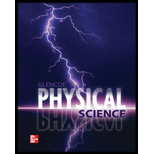
To explain: the identification and description of three ways through which the equilibrium can be shifted in a reversible reaction.
Answer to Problem 17STP
There are following three ways through which the equilibrium gets shifted which are given as,
- The equilibrium of a system is temporarily shifted out by the addition or removal of one or more reactants or products. These concentrations then undergo additional changes for back the system to equilibrium.
- If the gaseous system pressure at equilibrium is increase by decreasing the system volume or by the addition of more components of the equilibrium mixture, so, a stress is produced there by increasing the component’s partial pressure. Hence, by decreasing the pressure the reverse reaction will be favored.
- The internal energy of the system is increasing due to the increase in temperature. So, it also effects the amount of one of the reaction products. To relive the stress, the reaction will shift to the left side. So, there is an increase in the reactant’s concentration and there is a reduction in the product concentration and the amount of energy present is reduced due to the lowering of temperature. This temperature favors the heat production and product formation.
Explanation of Solution
Introduction:
By using Le Chatelier’ principle, the change in equilibrium concentrations can be predicted, when a system that is at equilibrium is subjected to a stress.
To predict the change in equilibrium concentrations, when a system that is at equilibrium is subjected to a stress, Le Chatelier’ principle is used. There are following three ways through which the equilibrium gets shifted which are given as,
- Effect on concentration in equilibrium: the equilibrium of a system is temporarily shifted out by the addition or removal of one or more reactants or products. These concentrations then undergo additional changes for back the system to equilibrium.
- The effect of change in pressure on the equilibrium: if the gaseous system pressure at equilibrium is increase by decreasing the system’s volume or by the addition of more components of the equilibrium mixture, so, a stress is produced there by increasing the component’s partial pressure. Hence, a shift in the equilibrium that reduces the total molecules per unit volume will be favored as this relieves the stress, according to the Le Chatelier’s principle. Hence, by decreasing the pressure the reverse reaction will be favored.
- Effect of temperature on the equilibrium: The value of equilibrium constants is changed by changing the temperature. The internal energy of the system is increasing due to the increase in temperature. So, it also affects the amount of one of the reaction products. To relive the stress, the reaction will shift to the left side. So, there is an increase in the reactant’s concentration and there is a reduction in the product concentration. The amount of energy present is reduced due to the lowering of temperature and this temperature favors the heat production and product formation.
Conclusion:
Thus, the three ways through which the equilibrium can be shifted in a reversible reaction is described above.
Chapter 19 Solutions
Glencoe Physical Science 2012 Student Edition (Glencoe Science) (McGraw-Hill Education)
Additional Science Textbook Solutions
Physics for Scientists and Engineers: A Strategic Approach, Vol. 1 (Chs 1-21) (4th Edition)
College Physics
Physics: Principles with Applications
Life in the Universe (4th Edition)
Cosmic Perspective Fundamentals
Tutorials in Introductory Physics
 College PhysicsPhysicsISBN:9781305952300Author:Raymond A. Serway, Chris VuillePublisher:Cengage Learning
College PhysicsPhysicsISBN:9781305952300Author:Raymond A. Serway, Chris VuillePublisher:Cengage Learning University Physics (14th Edition)PhysicsISBN:9780133969290Author:Hugh D. Young, Roger A. FreedmanPublisher:PEARSON
University Physics (14th Edition)PhysicsISBN:9780133969290Author:Hugh D. Young, Roger A. FreedmanPublisher:PEARSON Introduction To Quantum MechanicsPhysicsISBN:9781107189638Author:Griffiths, David J., Schroeter, Darrell F.Publisher:Cambridge University Press
Introduction To Quantum MechanicsPhysicsISBN:9781107189638Author:Griffiths, David J., Schroeter, Darrell F.Publisher:Cambridge University Press Physics for Scientists and EngineersPhysicsISBN:9781337553278Author:Raymond A. Serway, John W. JewettPublisher:Cengage Learning
Physics for Scientists and EngineersPhysicsISBN:9781337553278Author:Raymond A. Serway, John W. JewettPublisher:Cengage Learning Lecture- Tutorials for Introductory AstronomyPhysicsISBN:9780321820464Author:Edward E. Prather, Tim P. Slater, Jeff P. Adams, Gina BrissendenPublisher:Addison-Wesley
Lecture- Tutorials for Introductory AstronomyPhysicsISBN:9780321820464Author:Edward E. Prather, Tim P. Slater, Jeff P. Adams, Gina BrissendenPublisher:Addison-Wesley College Physics: A Strategic Approach (4th Editio...PhysicsISBN:9780134609034Author:Randall D. Knight (Professor Emeritus), Brian Jones, Stuart FieldPublisher:PEARSON
College Physics: A Strategic Approach (4th Editio...PhysicsISBN:9780134609034Author:Randall D. Knight (Professor Emeritus), Brian Jones, Stuart FieldPublisher:PEARSON





